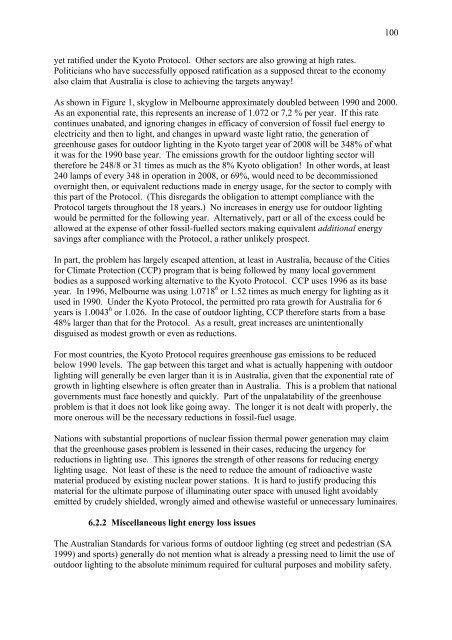Outdoor Lighting and Crime - Amper
Outdoor Lighting and Crime - Amper
Outdoor Lighting and Crime - Amper
You also want an ePaper? Increase the reach of your titles
YUMPU automatically turns print PDFs into web optimized ePapers that Google loves.
yet ratified under the Kyoto Protocol. Other sectors are also growing at high rates.<br />
Politicians who have successfully opposed ratification as a supposed threat to the economy<br />
also claim that Australia is close to achieving the targets anyway!<br />
As shown in Figure 1, skyglow in Melbourne approximately doubled between 1990 <strong>and</strong> 2000.<br />
As an exponential rate, this represents an increase of 1.072 or 7.2 % per year. If this rate<br />
continues unabated, <strong>and</strong> ignoring changes in efficacy of conversion of fossil fuel energy to<br />
electricity <strong>and</strong> then to light, <strong>and</strong> changes in upward waste light ratio, the generation of<br />
greenhouse gases for outdoor lighting in the Kyoto target year of 2008 will be 348% of what<br />
it was for the 1990 base year. The emissions growth for the outdoor lighting sector will<br />
therefore be 248/8 or 31 times as much as the 8% Kyoto obligation! In other words, at least<br />
240 lamps of every 348 in operation in 2008, or 69%, would need to be decommissioned<br />
overnight then, or equivalent reductions made in energy usage, for the sector to comply with<br />
this part of the Protocol. (This disregards the obligation to attempt compliance with the<br />
Protocol targets throughout the 18 years.) No increases in energy use for outdoor lighting<br />
would be permitted for the following year. Alternatively, part or all of the excess could be<br />
allowed at the expense of other fossil-fuelled sectors making equivalent additional energy<br />
savings after compliance with the Protocol, a rather unlikely prospect.<br />
In part, the problem has largely escaped attention, at least in Australia, because of the Cities<br />
for Climate Protection (CCP) program that is being followed by many local government<br />
bodies as a supposed working alternative to the Kyoto Protocol. CCP uses 1996 as its base<br />
year. In 1996, Melbourne was using 1.0718 6 or 1.52 times as much energy for lighting as it<br />
used in 1990. Under the Kyoto Protocol, the permitted pro rata growth for Australia for 6<br />
years is 1.0043 6 or 1.026. In the case of outdoor lighting, CCP therefore starts from a base<br />
48% larger than that for the Protocol. As a result, great increases are unintentionally<br />
disguised as modest growth or even as reductions.<br />
For most countries, the Kyoto Protocol requires greenhouse gas emissions to be reduced<br />
below 1990 levels. The gap between this target <strong>and</strong> what is actually happening with outdoor<br />
lighting will generally be even larger than it is in Australia, given that the exponential rate of<br />
growth in lighting elsewhere is often greater than in Australia. This is a problem that national<br />
governments must face honestly <strong>and</strong> quickly. Part of the unpalatability of the greenhouse<br />
problem is that it does not look like going away. The longer it is not dealt with properly, the<br />
more onerous will be the necessary reductions in fossil-fuel usage.<br />
Nations with substantial proportions of nuclear fission thermal power generation may claim<br />
that the greenhouse gases problem is lessened in their cases, reducing the urgency for<br />
reductions in lighting use. This ignores the strength of other reasons for reducing energy<br />
lighting usage. Not least of these is the need to reduce the amount of radioactive waste<br />
material produced by existing nuclear power stations. It is hard to justify producing this<br />
material for the ultimate purpose of illuminating outer space with unused light avoidably<br />
emitted by crudely shielded, wrongly aimed <strong>and</strong> othewise wasteful or unnecessary luminaires.<br />
6.2.2 Miscellaneous light energy loss issues<br />
The Australian St<strong>and</strong>ards for various forms of outdoor lighting (eg street <strong>and</strong> pedestrian (SA<br />
1999) <strong>and</strong> sports) generally do not mention what is already a pressing need to limit the use of<br />
outdoor lighting to the absolute minimum required for cultural purposes <strong>and</strong> mobility safety.<br />
100
















